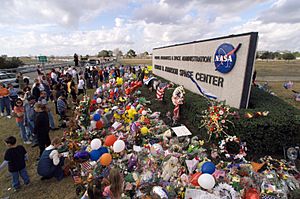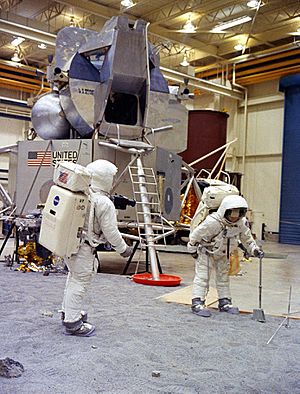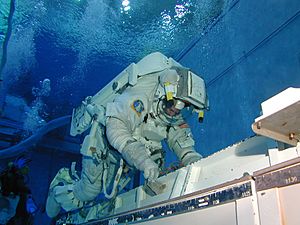Johnson Space Center facts for kids

Top to bottom, left to right: An aerial view of JSC with Space Center Houston in front, the Space Vehicle Mockup Facility, the Christopher C. Kraft Jr. Mission Control Center, the Neutral Buoyancy Laboratory, and the Space Center Houston Saturn V rocket exhibit.
|
|
| Abbreviation | JSC |
|---|---|
| Predecessor | Space Task Group |
| Formation | November 1, 1961 |
| Location | |
| Owner | NASA |
|
Director
|
Vanessa E. Wyche |
|
Staff
|
3,200 civil service |
| Website | JSC home page |
|
Formerly called
|
Manned Spacecraft Center |
The Lyndon B. Johnson Space Center (JSC) is a very important NASA center in Houston, Texas. It's where astronauts train for space, and where missions are controlled. It was first called the Manned Spacecraft Center. It was renamed on February 19, 1973, to honor Lyndon B. Johnson, a former US president from Texas.
JSC is a large campus with 100 buildings spread over 1,620 acres (656 hectares) in the Clear Lake Area of Houston. It is home to NASA's astronauts, and it trains them along with astronauts from other countries. JSC also has the Christopher C. Kraft Jr. Mission Control Center. This center has controlled every NASA human spaceflight since Gemini 4. This includes missions like Apollo, Skylab, Apollo–Soyuz, and the Space Shuttle. People often call it "Mission Control" or "Houston."
The original Manned Spacecraft Center grew from the Space Task Group (STG). This group, led by Robert R. Gilruth, was created to manage the US crewed spaceflight program. The STG was first located at the Langley Research Center in Hampton, Virginia. In 1961, plans began to make it a bigger organization and move it to a new place. The new facility was built in 1962 and 1963 on land given by the Humble Oil company through Rice University. It officially opened in September 1963. Today, JSC is one of ten main NASA centers. Houston is even called "Space City" because of it.
Contents
History of the Johnson Space Center
The Johnson Space Center started as NASA's Space Task Group (STG). From November 5, 1958, engineers at Langley Research Center, led by Robert R. Gilruth, managed Project Mercury. The STG first reported to the Goddard Space Flight Center. It had 45 staff members, including 37 engineers and eight "human computers." These "human computers" were women who did calculations using mechanical adding machines.
In 1959, 32 Canadian engineers joined the center. NASA's first administrator, T. Keith Glennan, realized the STG would need its own location. On January 1, 1961, he suggested choosing a new site. Later that year, President John F. Kennedy set the goal to land a person on the Moon. This made it clear that Gilruth would need a much larger team and new facilities for the Apollo Program.
Choosing the Location
In 1961, Congress approved $60 million for a new crewed spaceflight laboratory. NASA listed requirements for the new site. These included access to water for large barges, a mild climate, and easy access to commercial jet service. It also needed a strong industrial area, a culturally appealing community, and a university nearby. A good electric and water supply was also important, along with at least 1,000 acres (405 hectares) of land.
In August 1961, NASA asked John F. Parsons to lead a team to choose the site. The team first listed 22 cities, then narrowed it down to nine. These included:
- Jacksonville, Florida
- Tampa, Florida
- Baton Rouge, Louisiana
- Shreveport, Louisiana
- Houston, Texas
- Victoria, Texas
- Corpus Christi, Texas
- San Diego, California
- San Francisco, California
Another 14 sites were added, including two more in Houston near Rice University. The team visited all 23 sites between August 21 and September 7, 1961. Many politicians tried to influence the decision.
After their visits, the team's first choice was MacDill Air Force Base in Tampa. However, the Air Force decided not to close MacDill. This made the Houston Rice University site the top choice. NASA leaders informed President Kennedy on September 14, 1961. The public announcement of the Houston location was made on September 19, 1961.
Many people believe that Texas politicians had a big influence on this decision. Lyndon B. Johnson was Vice President and head of the Space Council. Other powerful Texans were also in key positions in Congress.
The land for the new center was 1,000 acres (405 hectares) donated to Rice University by the Humble Oil company. It was in an undeveloped area about 25 miles (40 km) southeast of Houston, next to Clear Lake. At the time, cattle grazed on the land. On November 1, the Space Task Group officially became the Manned Spacecraft Center.
Building the Center and Early Work
NASA bought an extra 600 acres (243 hectares) so the property would face a highway. Construction of the center began in April 1962. The new organization moved to temporary offices by September. That month, President Kennedy gave a famous speech at Rice University about the US space program. He mentioned the new center:
What was once the furthest outpost on the old frontier of the West will be the furthest outpost on the new frontier of science and space. Houston, ... with its Manned Spacecraft Center, will become the heart of a large scientific and engineering community. During the next 5 years the National Aeronautics and Space Administration expects to double the number of scientists and engineers in this area, to increase its outlays for salaries and expenses to $60 million a year; to invest some $200 million in plant and laboratory facilities; and to direct or contract for new space efforts over $1 billion from this Center in this City.
—John F. Kennedy, Speech at Rice University, September 12, 1962
The 1,620-acre (6.56 km2) facility officially opened in September 1963.
Mission Control Center

In 1961, as plans for Project Gemini began, it became clear that the Mercury Control Center at Cape Canaveral Air Force Station was not big enough. It couldn't handle missions with spacecraft that could move around, like Gemini and Apollo. Christopher Kraft and other flight controllers studied what was needed for a better control center.
The new Mission Control Center was built in Building 30 at MSC. Construction started in 1963. The new center had two Mission Operations Control Rooms. This allowed training for future missions to happen while a live mission was underway. It was used for testing during the uncrewed Gemini 2 flight in January 1965. It was also used for the first crewed Gemini flight, Gemini 3, in March 1965. The Mercury Control Center still controlled these early flights. The new center became fully active for the flight of Gemini 4 in June 1965. Since then, it has been the main control center for all US crewed space missions.
On April 14, 2011, NASA named the center the Christopher C. Kraft Jr. Mission Control Center.
Apollo Program and Renaming
JSC was also home to the former Lunar Receiving Laboratory. This is where the first astronauts returning from the Moon were kept in quarantine. Most of the lunar samples (Moon rocks) are still stored there. The center's Landing and Recovery Division used the MV Retriever in the Gulf of Mexico. Gemini and Apollo astronauts practiced getting out of their spacecraft after landing in the water.
On February 19, 1973, President Richard Nixon signed a law renaming the Manned Spacecraft Center. This was done to honor Lyndon B. Johnson, who had passed away four weeks earlier. Johnson, as Senate Majority Leader, had helped create NASA in 1958. Dedication ceremonies were held six months later on August 27.
One of the cool things you can see at Johnson Space Center is a Saturn V rocket. It's almost complete and made from actual parts that were ready to fly. It also has real Apollo command and service modules. These were meant for the canceled Apollo 19 mission.
In June 2019, the restored Apollo Mission Control Center opened for tourists.
Space Shuttle Program and Disasters

After the Space Shuttle Challenger disaster on January 28, 1986, President Ronald Reagan and First Lady Nancy Reagan visited JSC. They spoke at a memorial service for the astronauts on January 31. About 6,000 NASA employees and 4,000 guests attended, along with the astronauts' families. An Air Force band played "God Bless America." NASA T-38 Talon jets flew overhead in a "missing-man formation."
A similar memorial service was held at JSC on February 4, 2003. This was for the astronauts who died in the Space Shuttle Columbia disaster. President George W. Bush and First Lady Laura Bush attended.
On September 13, 2008, Hurricane Ike hit Galveston. It caused minor damage to the Mission Control Center and other buildings at JSC. The storm also damaged the roofs of several hangars for the T-38 Talons at Ellington Field.
Facilities at JSC
The Johnson Space Center is home to the Christopher C. Kraft Jr. Mission Control Center (MCC-H). This is NASA's control center for all human spaceflight in the United States. MCC-H managed all Space Shuttle missions. It now directs American activities on the International Space Station. The Apollo Mission Control Center, a National Historic Landmark, is in Building 30. From the moment a crewed spacecraft launches until it lands, Mission Control is in charge.
The MCC has several Flight Control Rooms. From these rooms, flight controllers manage and watch spaceflights. The rooms have many computers to monitor, command, and talk to spacecraft. When a mission is happening, the rooms are staffed 24 hours a day, usually in three shifts.
JSC handles most of the planning and training for US astronauts. It has training facilities like the Sonny Carter Training Facility and the Neutral Buoyancy Laboratory. The Neutral Buoyancy Laboratory is a very large pool. It holds about 6.2 million US gallons (23,000 m3) of water. Astronauts train here to practice spacewalks. This helps them get used to moving in zero-g conditions.
Building 31-N houses the Lunar Sample Laboratory Facility. This is where most of the Moon samples from the Apollo program are stored, studied, and processed.
The center also manages operations at White Sands Test Facility in New Mexico. This facility was a backup landing site for the Space Shuttle.
The visitor center for JSC has been the nearby Space Center Houston since 1994.
Personnel and Training

About 3,200 government employees work at Johnson Space Center. This includes 110 astronauts. Most of the workforce, over 11,000 people, are contractors. As of June 2021, the center's director is Vanessa E. Wyche.
NASA's astronaut training happens at the Johnson Space Center. Astronaut candidates learn about spacecraft systems. They also study basic sciences like math, navigation, astronomy, and physics. Candidates must complete military water survival training before they start flying. They also need to be scuba-qualified for spacewalk training. They must pass a swimming test. Spacewalk training is done at the Sonny Carter Training Facility. Candidates also learn how to handle emergencies related to air pressure. They are also exposed to the microgravity of space flight. Candidates keep their flying skills sharp by flying 15 hours a month in NASA's T-38 jets. These jets are based at nearby Ellington Field.
Research at JSC
Johnson Space Center leads NASA's science and medical research programs related to human spaceflight. Technologies created for spaceflight are now used in many areas. These include medicine, energy, transportation, agriculture, communications, and electronics.
The Astromaterials Research and Exploration Science (ARES) office does physical science research at the center. ARES scientists study Earth, planets, and space sciences. They also support human and robotic spaceflight programs.
Johnson Space Center received a five-year, $120 million extension. This was for its agreement with the National Space Biomedical Research Institute at Baylor College of Medicine. They study health risks from long space flights. This extension allows them to continue biomedical research through 2012.
The Prebreathe Reduction Program is a research study at JSC. It aims to make space walks from the International Space Station safer and more efficient.
The Overset Grid-Flow software was developed at Johnson Space Center with NASA Ames Research Center. This software helps simulate how fluids flow around solid objects.
The Texas Space Commission was created by Texas governor Greg Abbott on March 26, 2024, at Johnson Space Center.
Memorial Grove
Astronauts, center directors, and other NASA employees are remembered in a Memorial Grove. This grove is near the main entrance and visitor center. Trees dedicated to astronauts and directors are in a round group closest to the entrance. Other employees are remembered along a road leading to the main entrance.
Images for kids
-
A 2010 photo of JSC from the International Space Station
-
Space Shuttle Challenger atop its Shuttle Carrier Aircraft over JSC in 1983
-
Mission Control Center in 2005
See also
 In Spanish: Centro Espacial Lyndon B. Johnson para niños
In Spanish: Centro Espacial Lyndon B. Johnson para niños









